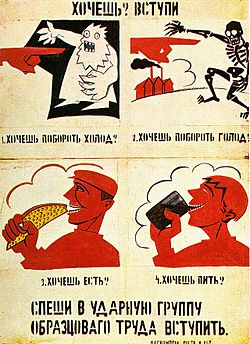Constructivism facts for kids

Constructivism was an exciting art and architecture style that started in Russia around 1913. Artists like Vladimir Tatlin believed that art should not just be pretty or "art for art's sake." Instead, they wanted art to have a real purpose in society. They thought art should help build a better world.
This art movement had a big impact on how things were designed. It influenced graphic designers who made posters and books, and industrial designers who created everyday objects. Constructivism was very active until about 1934. It also affected art in places like the Weimar Republic (Germany at the time). Later, a different style called Socialist Realism became more popular. However, ideas from Constructivism have appeared again in other art styles over the years.
Contents
What is Constructivism?
Constructivism was a new way of thinking about art. Artists wanted to use art to help society, especially after the Russian Revolution. They believed art should be useful, like a tool. They often used simple shapes, lines, and colors.
Art for a Purpose
Instead of painting traditional pictures, Constructivist artists focused on making things that could be used. They created posters, advertisements, buildings, and even clothes. Their goal was to make art that served a social or political message. For example, they made posters to encourage people to work hard or support new ideas.
Key Ideas and Materials
Constructivist artists often used modern materials like metal, glass, and plastic. They liked to show how things were put together, almost like an engineer building a machine. They believed that art should be like construction, building something new and strong.
- Geometric Shapes: They used lots of circles, squares, and triangles.
- Bold Colors: Often, they chose strong, basic colors like red, black, and white.
- Dynamic Compositions: Their artworks often looked like they were moving or spinning, showing energy and progress.
- New Materials: They explored using industrial materials instead of traditional paint and canvas.
Famous Constructivist Artists
Several artists were very important to the Constructivist movement.
Vladimir Tatlin
Vladimir Tatlin is often seen as one of the founders of Constructivism. He believed in making "real materials in real space." His most famous work was the design for the Monument to the Third International (also known as Tatlin's Tower). This huge, spiraling building was never built, but it showed his vision for a new kind of architecture.
Alexander Rodchenko
Alexander Rodchenko was a versatile artist. He worked in painting, sculpture, graphic design, and photography. He was known for his strong, geometric designs and his innovative use of photography to create new perspectives. He made many famous posters and book covers.
El Lissitzky
El Lissitzky was another key figure. He created a series of abstract paintings called "Prouns," which stood for "projects for the establishment of a new art." These works explored space and form in a revolutionary way. He also designed many influential books and exhibitions.
Influence on Design and Architecture
Constructivism had a huge impact beyond just fine art.
Graphic Design
The clear, bold style of Constructivism was perfect for posters, magazines, and advertisements. Its focus on strong typography (the style and arrangement of text) and simple images made messages easy to understand. This style still influences graphic design today.
Architecture
Constructivist architects designed buildings that looked like machines or factories. They used lots of glass and steel, and their buildings often had unusual, geometric shapes. They wanted buildings to be functional and reflect the new industrial age.
Industrial Design
Constructivist ideas also shaped industrial design. Artists thought about how everyday objects, like furniture or clothing, could be made more efficient and modern. They wanted to bring art into people's daily lives through well-designed products.
End of the Movement
By the mid-1930s, Constructivism began to fade as a main art movement in Russia. The government started to favor a different style called Socialist Realism, which was more traditional and showed heroic images of workers and leaders. However, the ideas and visual style of Constructivism continued to inspire artists and designers around the world for many years.
Images for kids
-
Spatial Construction
Spatial Construction #12: plywood, open construction partially painted with aluminum paint, and wire, by Alexander Rodchenko, 1920.
-
'Proun Vrashchenia' by El Lissitzky, 1919
See also
 In Spanish: Constructivismo para niños
In Spanish: Constructivismo para niños






